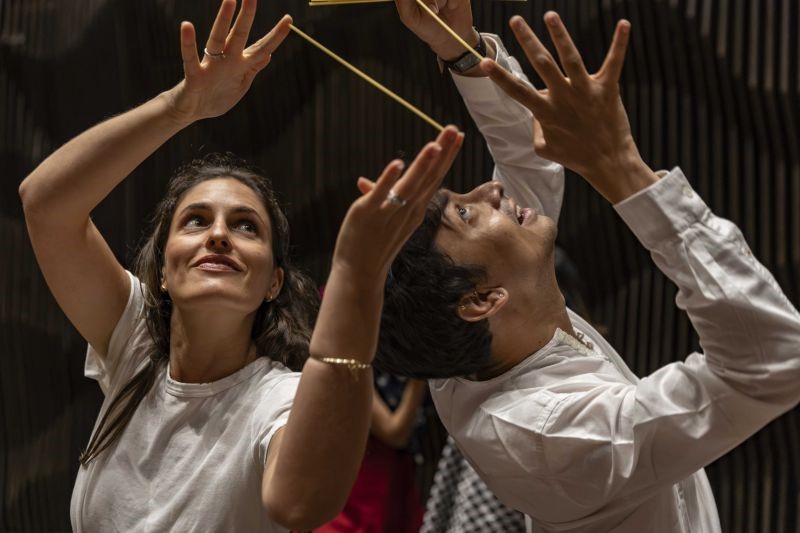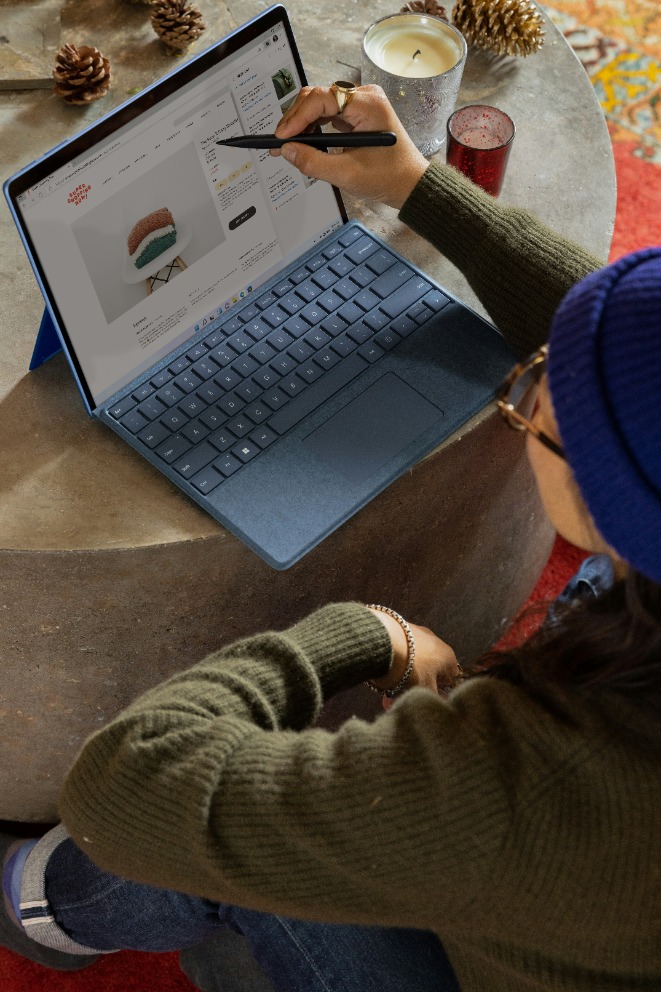On the push-pull of energy in cross-cultural arts programming
A key event in the Regional // Regional program, in March 2024 participants meet at the Theatre Royal, Hedburg, at the University of Tasmania, to combine performance art and cultural exchange.
23 February 2024

March 2024
The significance of a location shift was felt among the group as everybody ambled through the University foyer into its wood-panelled theatre.
Greeted by the sounds of double bass and the joy of Second Echo Ensemble’s members, it’s clear this is going to be a good morning and different to what’s come before.
In pairs, sat back-to-back, the group breathe into the new space together as ensemble member Dave Montgomery leads a meditative Acknowledgement of Country. People’s bodies react differently to this, but because of the baseline and connection that has formed across the week, there are fewer raised shoulders than in your average team-building exercise. Less hesitation and most importantly, more autonomy. As the ensemble emphasises: nothing has to be forced. This is a moment to observe the purity of your own body's movement. All becomes more kinetic, quite quickly, as Creative Director Kelly Drummond Cawthorn and the two ensemble members lead the group through what is essentially an ice-breaker activity or something straight out of a drama class.
A box of pasta is produced, golden threads of spaghetti becoming connective tissue between each pair. When held between opposing index fingers each discovers just how much pressure is enough to maintain the connection. Everybody has new boundaries to negotiate with their partner as this flimsy piece of cylindrical wheat threatens to spring forth, fall or snap into pieces.
Having the freedom to observe this group activity was joyful in many ways. There was no choice but to commit to the space between you and your partner. Eventually releasing ego, to an extent, in order to preserve the spaghetti. Kelly helpfully chimed around this moment ‘Nobody's looking at you, they're just looking at their spaghetti.’ And then as the first pair snaps ‘You can't do it wrong, just prepare for your spaghetti to break.’

This is a room of arts producers and it’s clear some are from the performance end of town. They respond well to the proximity of others and are quick to join in with big, expressive moment. Yet, others just do at their own scale. Some are wallflowers whose roots are planted more firmly and move only gently in the breeze. All ranges of movement and comfortability are catered for here, because the ensemble sets the tone with their own movements, and the director reminds you of this, in good humour. As someone who found a movement practice later in life–yoga, running, dance, acting–I can’t help but find these instructions revolutionary, overdue, welcome.
The pairs add another piece of spaghetti to the space between their bodies. Crook of an elbow, forearm, shoulder, breast-bone, heart-space. How to move around together holding this energetic force between them. Using spaghetti to make visible the tension between push-pull. Is this a metaphor for arts producers? You can't sustain just pushing. You have to let yourself be pulled toward another.
Kelly calls it ‘a heart-felt connection of a dance. The design between two bodies in problem solving an obstacle.’ Usually, we want to get the thing out of the way. But what if we incorporated it, and it’s no longer an obstacle?

From the balcony, I see the protective nature of humans creeping back in: we are adults, many raised in Western Cultures, who want our personal space. Give people the freedom to create connection points between two bodies and instead of the heart, we will go back to the brain. The hands. Move energy further away from the source. How proximity and interaction has come to scare us. Connection scares us. At the same time we crave it, that's almost the only thing we want.
Now the music changes. Many textures of double bass scored the partnerwork, but it takes on a new depth (a roundedness?) as Kelly asks, how do we–without talking–make a shape that's not a circle or a line? Everybody's partnership and rapport is under pressure to perform. Perhaps it has been building to this point. Because the next challenge, perhaps inevitably, is: how does the spaghetti get around the circle?
There is a purity, playfulness and lightness to everything that happens within this circle. Everybody’s concerns and calculations have faded from their eyes, which gleam with childlike energy. Everybody has touched the piece of spaghetti and thus, has a stake in its life cycle as it moves further around the group. There’s genuine care and investment behind everybody’s interest, but gently. Remembering that at the end of the day, it’s just spaghetti. If it breaks, it’s just spaghetti. Everybody’s so committed to the bit that they can’t tell what I can tell in that moment, sitting up in the wings. As much as an arts practice is co-created energy, deeply serious and authentic, transferred between people and different bodies, it can be as flimsy as a piece of spaghetti.
Could it be just as insignificant as one too? One piece of spaghetti gets lost among many, as Kelly now pours out the rest of the package of spaghetti into the middle of the room. Choreographing fallen and broken bits, how will they silently arrive at a shared vision for what this whole could be?
Negotiations begin, as the pasta pile in the middle is gently prodded and pondered by upright citizens. Then! Sho dives through and creates a beautiful body-slam-river splaying out the yellow. It becomes stepping stones that Jude tiptoes over. Tony skates through. Dave dives through, a snow angel - spaghetti angel. Sarah gives it a delicate ballet-style flick. Ash goes in with baby Lucinda who surveys, as she always does, approving this configuration through her big brown eyes. Jih Wen creates a pasta trail back towards the standing human circle, an outline of Kelly who has laid down with some underneath her as well. Now others lay down. Suddenly there’s a rush of people towards the centre. People seem to have realised something collectively and are now swarming the middle. In fact there is no longer a circle. The music becomes melodic and sweet, toward a finite movement of resolution, then hurried, as people seem to remember what they wanted to do, and realise what final means for them and perhaps the entire group. It was sweetly resolved with half on the floor.

Closing remarks from the group bring us back to the present. A buzz of connection reverberates in the room, hardwood floors of the theatre and curved wooden lines of the balcony echoing Mount Wellington/Kunanyi outside, whose presence stands over hobart/Nipaluna.
The Regional // Regional members share an overwhelming gratitude for the fact that time has been allowed for space of real connection and intimacy to develop. Jih-Wen Yeh, of Step Out Arts-Taiwan, says she loved the energy, thought and care in the room. How there was a collective slowing down but sense of play. Everybody wonders at how these things can coexist.
Ilda Karwayu of Makassar International Writers Festival rightly says that time stopped for a while as everybody just focused on being here. Jules Caburian of 23 Sampaguita Artist Collective agrees, and was grateful for focus and realignment, to meet everyone where they are.
Melania Jack, of NorthSite Contemporary Cairns, noticed how confidence grew across the group, to trust and try new things together. Tony Yap, MAP Fest, reflects on sitting back-to-back with Dave during the meditation at the start of the session. Though neither were moving, their breath moved at the same time. Makoto Kuzuya, Sanriku International Arts Festival, says it's good to get out of the cerebral and spend time together in a physical sense. His translator Sho Ikushima saying it's good to move together.
Alex Wisser, Cementa, says how good it is to experience a level of intimacy with people who you're only just getting to know. Feeling nervous, but feeling safe, he has a level of wonder at what stars had to align for the energies in this room to knit together so well and so graciously.
The gratitude circle ends with laughter, a reminder it's not all so serious.
Your piece of spaghetti might break but that's okay because it's just spaghetti.

Written by Susie Anderson
Susie Anderson is a writer of poetry and nonfiction whose work reflects on the hidden layers of culture, memory and place. She is a proud Wergaia & Wemba Wemba woman from Western Victoria whose poetry and non-fiction writing has been published in a variety of publications in Australia and abroad, including Meanjin, Rabbit Poetry Journal, Cordite Poetry Review, Suburban Review, Portside Review, Archer Magazine and more. She has also written extensively about visual art from a First Nations lens for galleries such as National Gallery of Victoria and publications like un Magazine, Artist Profile, Artlink and Art Monthly. Her debut collection of poetry, the body country, was published in 2023 and shortlisted for the Victorian and NSW Premier's Literary Awards.
Artist practise movement session led by Second Echo Ensemble
At the heart of Second Echo Ensemble are the artists who make and perform the work. Some live with disabilities, and some do not. Our work is not simply about access or equality. We are about new ways of thinking and creating.
Based in nipaluna/ Hobart, the company has toured around Australia and internationally, and is a leading creative force in the development of a narrative that speaks to the rich diversity of Tasmania.
All photos by Jillian Mundy
How can we help? Get in touch to discuss how we can help you engage with Asia
